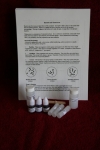| Thetacoccus
Concerns about contamination, preparation and the cost of bacterial support materials make usually limit the study of bacteriology to microscopic observation.~Bacteria, however, provide a method of studying both morphological and biochemical aspects of a simple life form.
Thetacoccus, simulated bacteria, provide both the biochemical and morphological subjects without the danger and inconvenience of actual living bacteria.
Thetacoccus is not alive.~The culture needs no refrigeration or storage at low temperatures.~For most biochemical tests, a water bath of 37 deg C for 1 - 2 hours is all that is needed to perform a biochemical test.~The testing solutions, and original culture need no incubation and can be disposed of by pouring down the drain.~Destructive sterilization of used cultures is not necessary.
Since Thetacoccus is not alive and the cultures are in use for very short time, there is no danger of co-breeding pathogenic bacteria or viruses.
All Thetacoccus bacterial cultures, test solutions and slides can be disposed of without excessive treatment.~Solutions of the culture and test solutions can be disposed of by pouring down the drain followed by at least three gallons of water.
Solid or dried out cultures, slides and other solid materials can be safely disposed of in the trash.~There is no danger of bacterial contamination.
The kit contains enough material for over 200 Gram stains, enzyme tests and identification lab suggestions.
- 1 Vial Thetacoccus culture
- 1 Vial of Media
- 1 Vial of Crystal violet stain
- 1 Vial of Safranin counterstain
- 1 Vial of Iodine
- 1 Vial of Gelatin
- 1 Vial of Protease
- 1 Vial of Rennin
- 1 Set of directions
- 12 Plastic slides
- 15 Stirring splints (toothpicks)
|
 Thetacoccus Kit
Thetacoccus Kit Thetacoccus Kit
Thetacoccus Kit